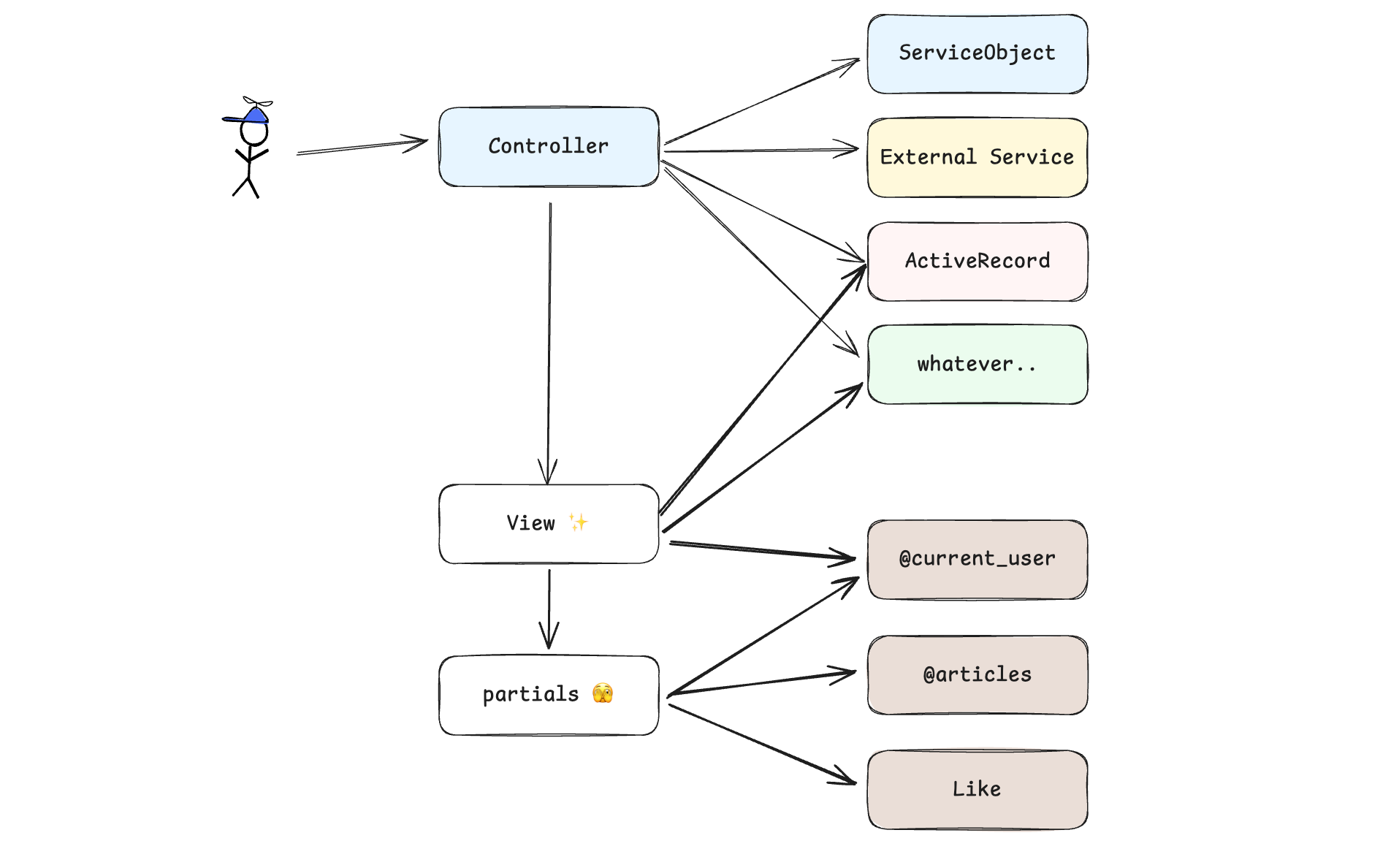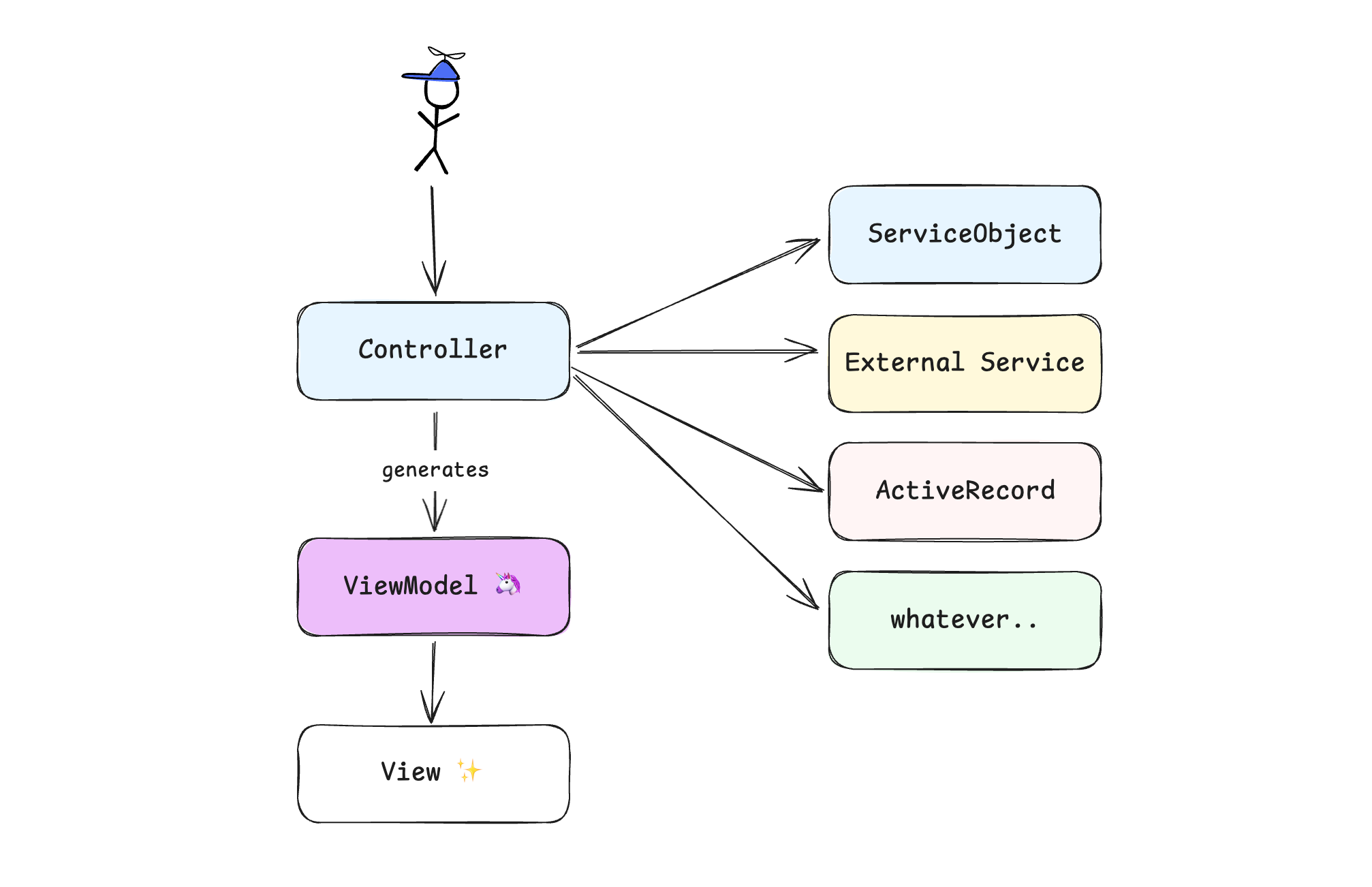View Models in Rails: An experiment to solve the chaos
Rails views start simple, but they can quickly turn into a mess. Business logic creeps in, performance suffers, and suddenly your views are making decisions they shouldn’t.
Since Rails first appeared, one thing that’s barely changed is how we build and render views. If you’ve worked with Rails, you’re familiar with those ERB files following the CRUD pattern - index/show/edit and so on. Usually, you’re rendering one Model at a time, or at most something related to the user.
As your application grows, you add new Models and relationships. Before you know it, you’re accessing them directly in your views. Then a few hours later, you’ve started adding business logic to your views:
<% if current_user.subscription.active? %>
...
<% end %>
This might seem reasonable at first. I was personally okay with it too! But after years of working this way, I started noticing all this logic scattered across views and partials. It was becoming a real mess.
Even worse, Ruby code was mixed with HTML, class names, inline CSS, and inline JavaScript!
No more!
The Pain Points
If you’ve worked on a Rails app that’s grown beyond a simple CRUD application, you’ve probably run into these problems:
Several Models or variables accessed in views
This is probably the biggest issue: we tend to access multiple ActiveRecord models or variables containing them to the point where it’s practically impossible to track what’s used where.
def show
@current_user = User.last
@articles = @current_user.articles(since: 1.month.ago)
@friends = ...
@suggested_friend = ...
end
Later on in the view:
<% if @current_user %>
<% @articles.each do |p| %>
<%= render partial: "post_with_friends", friends: @friends %>
<p>Like count: <%= Like.count(aggregate_id: articles.aggregates.last.id) %></p>
<% end %>
<% end %>
Some are instance variables from the controller, others are direct calls to ActiveRecord Models because you might not have a clear relationship between the two entities.

Business Logic Sneaking Into Views
Another major pain point: Views should be about presentation, but they often become decision-makers.
<% if user.articles.where(published: true).count > 0 && user.subscription.active? %>
<div class="premium-content">
<%= render partial: "premium_content" %>
</div>
<% end %>
Even without mentioning the Single Responsibility Principle, your view is now making business decisions about who should see what content.
We might try to fix this by creating a new scope or method in the Model, but that’s not really a fix—it’s just postponing the problem. Eventually, you’ll need to limit the number of records or manipulate them in a way that’s specific to a single view, and that’s not a Model’s responsibility.
Performance Issues
Ever noticed your pages getting slower as your app grows? It might be those innocent-looking view snippets:
<% @users.each do |user| %>
<div class="user-card">
<h3><%= user.name %></h3>
<p>Articles: <%= user.articles.count %></p> <!-- N+1 query alert! -->
<p>Last active: <%= user.last_active_at.strftime("%B %d, %Y") %></p>
</div>
<% end %>
That harmless user.articles.count creates an N+1 query that can bring your app to its knees as your user base grows.
Lack of Centralization
When business rules are scattered across views, making changes becomes a treasure hunt:
<!-- In users/show.html.erb -->
<% if user.premium? && user.verified? %>
<!-- In articles/index.html.erb -->
<% if current_user.premium? && current_user.email_verified? %>
<!-- In dashboard/index.html.erb -->
<% if current_user.subscription.status == "active" && current_user.verified_at.present? %>
Notice how the same business rule is implemented three different ways? Good luck updating that logic consistently!
Testing Becomes a Nightmare
How do you test view logic? It’s hard to isolate, hard to mock, and often requires slow integration tests.
Here are a few options:
System Testing

We don’t do this anymore. As DHH says, stop writing so many system tests - you should only have a few to test the general behavior of your app. They’re not feasible for testing various field value combinations to figure out how your view renders.
Partial Rendering Testing
We can test views in isolation, right? Yes, but I don’t want to test the view itself, because the interesting part is in the data. The view is data-driven, so I’m more interested in testing the data that the controller outputs.
The important bit is understanding when the current_user might be nil, not why the view isn’t rendering the user profile, which is just a direct consequence.
If I can remove any logic from the view and make it behave 1-to-1 with the controller, I can test that the ERB file doesn’t contain errors and the controller output is correct. That gives me 99.99% assurance the view will render as expected.
Experimenting with View Models
A View Model sits between your controller and view, handling all the presentation logic and data preparation. Think of it as a specialized object that knows exactly what your view needs.
What Is a View Model?
In its simplest form, a View Model is a plain Ruby class that:
- Takes in your modelS and any other context
- Provides methods that your view can call
- (Optional) Handles all the presentation decisions
- Is the only DTO used in your views for that request
Here’s a basic example:
UserProfileViewModel = Data.define(:current_user, :show_premium_content) do
def display_name
current_user.full_name || current_user.username
end
end
How to Use It in Your Controller
class ProfilesController < ApplicationController
def show
user = User.find(params[:id])
@vm = UserProfileViewModel.new(
current_user:,
articles: current_user.articles.since(1.month.ago),
show_premium_content: current_user.subscription.active?
)
end
end
And in Your View
<div class="profile-header">
<h1><%= @vm.display_name %></h1>
<p>Member since <%= @vm.current_user.created_at %></p>
</div>
<% if @vm.show_premium_content %>
<div class="premium-content">
<%= render partial: "premium_content" %>
</div>
<% end %>
<div class="recent-articles">
<% @vm.articles.each do |article| %>
<%= render partial: "article", locals: { article: article } %>
<% end %>
</div>
<%= render(partial: "invoices", current_user:) %>
The Benefits
Centralized Logic and Unidirectional Flow
All your presentation decisions live in one place: the controller. Need to change how premium content access works? Update it in one method, not across dozens of views.
This leads to a unidirectional flow with the Controller doing the heavy lifting of putting all the pieces together, calling Models and ServiceObjects to get all the required information, building a ViewModel, and passing it to the view.

Better Performance
View Models let you eagerly load exactly what you need:
@vm = UserProfileViewModel.new(
current_user:,
articles: current_user.articles.includes(:comments).since(1.month.ago),
show_premium_content: false
)
Need this logic in multiple controller routes? You can:
- Move it into the
UserProfileViewModel - Create a ServiceObject
Semantic Clarity
Your view doesn’t need to know why premium content is shown, just if it should be shown:
<% if @vm.show_premium_content %>
<!-- content here -->
<% end %>
The method name clearly communicates intent, not implementation details. This means that if some users have been nice to us, we can show them premium content by updating the code in the controller, without changing the view.
Implementation Guidelines
Where to Put Your ViewModels
I like to create a dedicated directory and a view model for each route my app is rendering:
app/
view_models/
user_profile_view_model.rb
dashboard_view_model.rb
post_show_view_model.rb
post_index_view_model.rb
Type Safety for Extra Confidence
(Just an idea, I haven’t tested it personally)
If you’re using Sorbet, RBS or other type checking tools, View Models are a perfect place to add type annotations:
# With Sorbet
class UserProfileViewModel
extend T::Sig
sig { params(current_user: User, Boolean).void }
def initialize(user, current_user)
@user = user
@current_user = current_user
end
sig { returns(String) }
def display_name
@user.full_name || @user.username
end
end
Testing Made Easy
View Models are just plain Ruby objects, which makes them incredibly easy to test:
RSpec.describe UserProfileViewModel do
describe "#show_premium_content" do
it "returns true for active subscribers viewed by admins" do
current_user = create(:user, :with_active_subscription)
show_premium_content = true
view_model = UserProfileViewModel.new(current_user:)
expect(view_model.show_premium_content).to be true
end
end
end
But the interesting part is how we test the ViewModel generated from the controller using request specs:
describe "GET /user/profile" do
context "when user signed in" do
before { sign_in user }
it "renders the profile page" do
get user_profile_path
expect(assigns[:vm]).to be_a UserProfileViewModel
expect(assigns[:vm].current_user).to eq(user)
expect(assigns[:vm].articles).to eq(user.articles.first(10))
expect(assigns[:vm].show_premium_content).to be(true)
expect(response).to render_template(:profile)
end
end
context "when NOT signed in" do
it "do NOT render the profile page" do
get user_profile_path
expect(assigns[:vm]).to eq(
UserProfileViewModel.new(
current_user: user,
articles: []
show_premium_content: false
)
)
expect(response).not_to render_template(:profile)
end
end
end
Alternatives and Trade-offs
View Models aren’t the only solution to these problems. Here are some alternatives:
Presenters/Decorators (Draper)
Decorators wrap a single model and add presentation methods:
class UserDecorator < Draper::Decorator
def display_name
object.full_name || object.username
end
end
Good for simple presentation logic tied to a single model but less ideal for complex views that pull data from multiple models.
View Components (ViewComponent)
GitHub’s ViewComponent library lets you create reusable view components with their own logic:
class UserCardComponent < ViewComponent::Base
def initialize(user:)
@user = user
end
def premium?
@user.subscription.active?
end
end
Good for reusable UI elements that appear across many pages but less ideal for page-specific presentation logic.
Cells
Cells are mini-controllers for parts of your UI:
class UserCell < Cell::ViewModel
def show
render
end
def premium?
model.subscription.active?
end
end
Good for complex, reusable UI components with their own templates but less ideal for simple presentation logic. This is the closest one to my vision of ViewModels, but it strongly links the UI and logic, adds a new dependency, and introduces a new way of doing things.
When to Use View Models
View Models shine when:
- Your views access multiple models
- You have complex presentation logic
- You want to improve performance with eager loading
- You need to test your presentation logic thoroughly
They might be overkill for:
- Very simple CRUD applications
- Views that only display a single model with minimal logic
Personally, I’m introducing them in Coney.app, one of my most active side projects. I’ve already converted dozens of routes to this pattern and I’m really happy with the results. I’ve discovered many edge cases that are now covered by tests, making the application more reliable.
Next Steps
I’m considering using Literal to add type checks to the ViewModels to make them even safer. I’m also trying to build some conventions around this pattern and might create a gem in the future to share what worked in my case.
Wrapping Up
View Models aren’t a silver bullet, but they’re a powerful tool for keeping your Rails views clean, performant, and maintainable. They really shine in complex applications where views pull data from multiple sources and need to make presentation decisions.
The best part? You can introduce them gradually. Start with your most complex views, create View Models for them, and see the difference it makes. You don’t need to refactor your entire application at once.
Have you tried using View Models in your Rails applications? What worked (or didn’t) for you? Try refactoring one complex view with a View Model—you might never want to go back to the old way!
Keep reading

View Models in Rails: An experiment to solve the chaos
Learn how View Models can help you clean up messy Rails views, improve performance, and make your code more maintainable.

How to deploy a React and ExpressJS monorepository to Heroku
Deep dive into the Heroku build phases in order to deploy an application built on top of React, Express and Yarn Workspaces from a single GitHub repository

Best Visual Studio Code extensions and settings for Ruby and Rails
Best Visual Studio Code extensions and settings to work with Ruby and Ruby on Rails and bring several RubyMine features.



